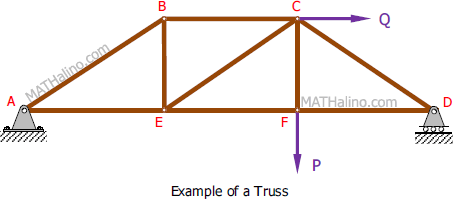Analysis of Structures
There are many kinds of structure. This section will limit to those that are pin-connected. Two types of pin-connected structures will be covered here; pin-connected trusses and pin-connected frames. In the actual structure, the joints may be welded, riveted, or bolted to a gusset plate at the joint. However as long as the center-line of the member coincide at the joint, the assumption of a pinned joint maybe used.
Analysis of Simple Trusses
An ideal truss is a structure which is composed completely of axial members that are assumed to be weightless. Members are connected by pinned joints, forming triangular substructures within the main structure and with the external loads applied only at the joints.

In real trusses, of course, the members have weight, but it is often much less than the applied load and may be neglected with little error. Sometimes, the weight maybe included by dividing the weight in half and allowing half the weight to act at each end of the member.
Our primary interest is to know the forces acting in the bars and upon the pins of the structure. Each member of the truss is either in tension or compression. A member in tension causes forces which pull away from its end joints whereas a member in compression causes forces which push towards the end joints.
- Log in to post comments
